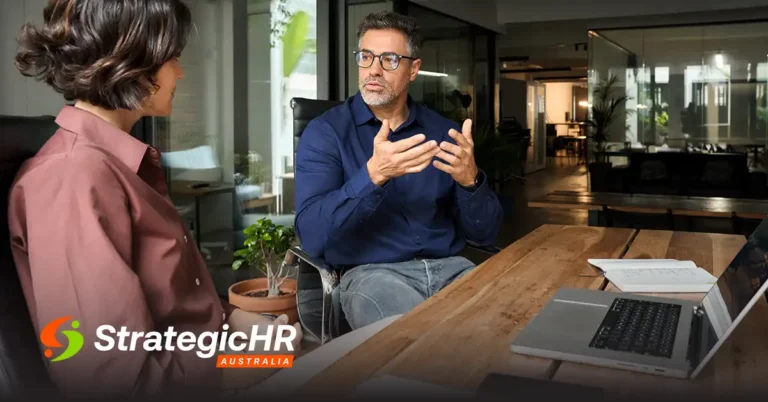Best-practice steps, tips, and your next action plan
Workplace investigations aren’t something most employers look forward to—but when an issue arises, knowing how to handle it effectively is essential. Whether it’s a complaint of bullying, harassment, misconduct, or a safety breach, how you respond can affect your legal exposure, your culture, and your team’s trust in leadership.
The moment an issue is raised, your response matters. A poor approach can escalate tensions or expose your business to risk. A clear, fair, and timely process, on the other hand, protects your people and your reputation.
This practical guide outlines 7 key steps to conduct a workplace investigation lawfully and fairly in Australia, whether you’re dealing with bullying, misconduct, discrimination or a serious breach of policy.
Step 1: Receive the Complaint
Acknowledge the concern in writing and reassure the individual that it will be addressed in a timely and fair manner. This ensures the issue is acknowledged respectfully, and sets the tone for a fair, timely, and legally defensible process.
- Before taking any action, pause and document the complaint—especially if it was raised verbally.
- Acknowledge receipt and assure a review will follow.
- Assess any immediate risks:
- Are there safety concerns?
- Is there a risk of retaliation or escalation?
- You may need to separate staff temporarily or stand someone down with pay.
Step 2: Appoint an Investigator
Choose someone impartial with the right skills and training. If that’s not possible internally, outsource to a professional.
- Decide who will investigate—if bias is a concern, appoint an external party.
- Ensure the investigator has appropriate skills and training for conducting fair investigations.
- The investigator should be someone who can remain neutral and objective throughout the process.
Step 3: Plan the Investigation
Clarify the scope, decide what evidence is needed, and create a timeline. This avoids mission creep and keeps it focused. We provide clients with frameworks to ensure investigations stay focused.
- Define the scope clearly. What exactly are you investigating? Reduce the issues into 2–3 clear allegations.
- Develop clear Terms of Reference that outline:
- What’s being investigated
- The standard of proof (“balance of probabilities”)
- Key timeframes
- Ensure all parties understand:
- Confidentiality expectations
- Access to support (EAP or external services)
- The respondent’s right to respond and bring a support person
Step 4: Gather Evidence
Collect documents, emails, logs or anything else relevant. Keep your process transparent and your records secure.
- Gather supporting evidence such as:
- Emails, rosters, policies, software logs
- CCTV footage (if available and relevant)
- Photos, diagrams, or other physical evidence
- Always retain original copies and ensure evidence is stored securely and confidentially.
- Document everything—what was collected, from whom, and how.
Step 5: Interview Relevant Parties
Speak to the complainant, the respondent, and witnesses. Ensure procedural fairness and allow all parties a chance to respond. Our trauma-informed investigators are trained to interview respectfully while maintaining legal compliance.
- Start with interviews—complainant, any relevant witnesses, and respondent.
- Use open questions first to let people share freely, then move to more targeted inquiries.
- Give all parties a fair opportunity to respond—with a support person if desired.
- Ensure procedural fairness throughout the interview process.
Step 6: Make Findings
Analyse all evidence. Were allegations substantiated or not? Document your reasoning clearly. This step is about reaching conclusions based on facts, not assumptions or bias. Findings are tied directly to facts and policy, using the required ‘balance of probabilities’ legal standard, which simply means it’s more likely than not that the alleged conduct occurred.
- Assess credibility:
- Look for consistency between statements and supporting materials
- Consider motives or potential bias in each account
- Compare conduct against:
- Company policies
- Workplace legislation (e.g. Fair Work Act, WHS regulations)
- Contractual obligations
- For each allegation, determine if it is:
- Substantiated
- Not substantiated
- Inconclusive
- Document your findings clearly and tie them directly to the evidence.
- Remain neutral and avoid subjective language—stick to facts and fair assessment.
Step 7: Recommend Actions
Based on the findings, recommend appropriate next steps—from no action to disciplinary measures or mediation. Every recommendation from Strategic HR is backed by evidence, process integrity, and tailored outcomes.
- Compile an impartial investigation report that includes:
- The process followed
- The evidence reviewed
- The findings for each allegation
- Communicate the outcome appropriately:
- Be respectful of confidentiality
- Clarify next steps
- Provide support for affected parties
- Take appropriate action—this might include:
- Disciplinary measures
- Policy changes
- Training or mediation
- Follow up within 30–60 days to ensure:
- The issue hasn’t resurfaced
- No retaliation or residual distress is occurring
Best Practices for Workplace Investigations
- Give all parties a fair opportunity to respond — with a support person if desired.
- Never promise anonymity if it cannot be guaranteed.
- Avoid reactive decisions — remain calm, impartial, and consistent with policy.
- If you must suspend someone, do so with pay and only when justified by risk — not as punishment.
- Document everything — your notes could be reviewed in court or by Fair Work.
Key Takeaway
Fair investigations aren’t just about “doing the right thing”—they’re also your best defence if a claim is made. Following a clear process demonstrates procedural fairness and can protect your business from legal and reputational fallout.
How Strategic HR Can Help
At Strategic HR Australia, we help business owners and managers navigate investigations with professionalism and care:
Independent Investigations
Handled impartially by our Director, Elisia — a trained workplace investigator and nationally accredited mediator.
Manager Training
Workshops on fair fact-finding, procedural fairness, and effective note-taking.
Policy Development
Custom policies aligned with Fair Work, WHS, and anti-discrimination legislation.
Need guidance on a current matter — or want to prepare before issues arise?
We’re here to help. Contact us today for a confidential discussion.







